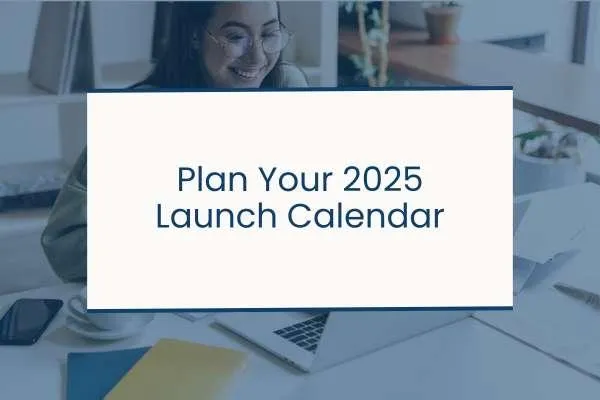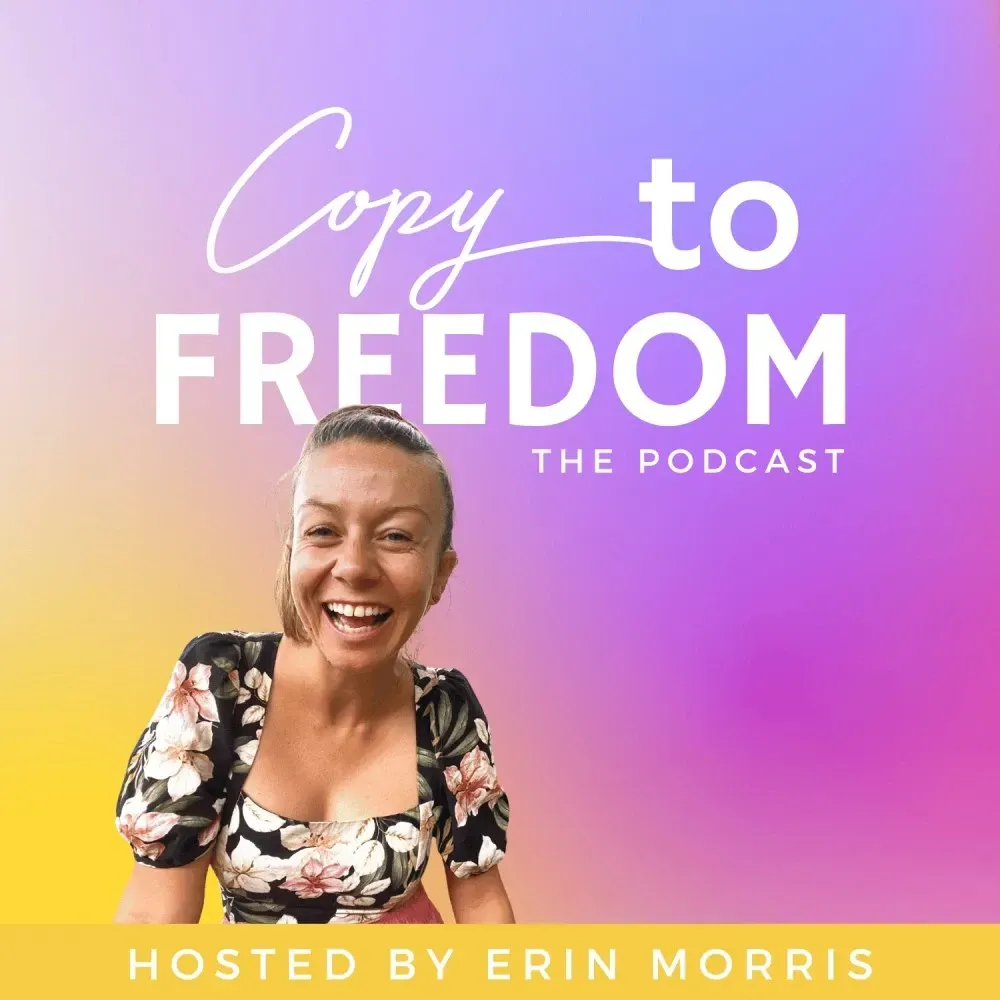Copywriting Podcast for Coaches & Course Creators
COPY TO FREEDOM
Upgrade your launch copywriting, create connection-first copy and build a freedom business with scalable offers.
Copywriting Podcast for Coaches & Course Creators
COPY TO FREEDOM
Upgrade your launch copywriting, create connection-first copy and build a freedom business with scalable offers.
Latest Episodes

07 Plan Your 2025 Launch Calendar Like a 7-Figure CEOLike a 7-Figure CEO
“When you plan quarterly launches, you create predictable sales cycles, avoid last-minute scrambling, and free up time to focus on growing your business intentionally.”
Plan Your 2025 Launch Calendar Like a 7-Figure CEO
Are you ready to crush your 2025 revenue goals while keeping your lifestyle-first business running like clockwork? Live launches can feel overwhelming and chaotic, but with the right planning, they can become predictable revenue drivers that allow you to scale without stress.
In this blog, I’ll show you how to create a 2025 launch calendar that sets you up for consistent success. From pre-launch timelines to managing quarterly launches, you’ll learn actionable strategies to create a simplified and scalable business model.
Here’s what we’ll cover:
Why pre-launch is the key to avoiding burnout and boosting conversions.
Step-by-step guidance for mapping out your quarterly launch calendar.
How to align your launches with key dates and buyer psychology.
The power of an ascension launch strategy to build momentum.
When and how to hire the right support for your launches.
Let’s plan your most profitable, stress-free year yet!
Why Planning Matters for Stress-Free Launches
Here’s the truth: most live launches don’t fail because of the offer or the product—they fail because of poor planning. Without a clear timeline, you can easily find yourself scrambling to get assets finished, burning out during pre-launch, and ultimately attracting fewer buyers because your energy is drained.
Potential clients want to work with someone who feels confident, in control, and ready to serve—not someone who's just barely making it to the finish line.
This blog will show you how to plan intentionally, simplify your efforts, and approach your launches like a 7-figure CEO.
1. The Importance of Leaving Enough Prep Time
If there’s one thing I’ve learned from supporting dozens of successful launches, it’s this: the time you dedicate to pre-launch can make or break your results.
The Problem with Skipping Pre-Launch
Imagine this: You come up with an amazing course idea and set a launch date for next month. You’re excited, but as the date approaches, you realize your audience isn’t ready to buy. Why? Because you didn’t warm them up. They’re not yet problem-aware or convinced your offer is the solution they need.
Skipping pre-launch is like trying to bake a cake without preheating the oven. Everything falls flat.
How Long Should You Prepare for a Launch?
Here’s a general guide:
8–12 weeks for a re-launch of an existing offer.
12–16 weeks for a new offer or if you’re newer to launching.
If you’re consistently re-launching the same offer, you can shorten this timeline over time as you’ll have reusable assets and a loyal audience.
Breaking Projects into Manageable Tasks
One of the biggest mistakes I see is treating projects like tasks. For example, “Create Masterclass” isn’t a task—it’s a project with multiple moving parts.
Here’s how to break it down:
Example: Create Masterclass
Decide on the masterclass topic.
Write the script or outline.
Create slides (or outsource this).
Write all email sequences (promo, reminder, thank-you, show-up).
Design the landing page and thank-you page.
Set up automations, Zoom links, and calendar invites.
Schedule social media promos.
By breaking down projects like this, you’ll have a clearer picture of what needs to be done and how long it will take.
Pro Tip: Always leave a buffer in your timeline. Life happens—whether it’s a sick child or a contractor delay. Give yourself breathing room.
2. Plan 2025 Like a CEO
Planning quarterly launches isn’t just about revenue—it’s about focus and simplicity. Instead of chasing every shiny idea, quarterly launches create natural cycles of preparation, execution, and reflection.
How to Plan Your Launch Calendar
Block off personal time first. Whether it’s school holidays, vacations, or just downtime, mark it on your calendar. This ensures you don’t end up launching during stressful periods.
Set your launch dates. Identify when your cart will open and close, and block out the pre-launch period (4–8 weeks beforehand).
Work backward. Map out every task and milestone needed for your launch—from course creation to email sequences—so you know exactly what needs to happen when.
3. Align Your Launch Calendar with Key Dates
Timing is everything. Think about external factors like holidays, seasons, and buyer behavior when setting your launch dates.
Questions to Ask Yourself
Is your offer time-sensitive? For example, fitness programs sell well in spring, while goal-setting courses thrive in January.
Are there promo periods to leverage? Black Friday and back-to-school season are ideal for discounts or bundles.
What’s happening in your audience’s lives? Avoid major holidays or times when they’re likely distracted.
Aligning your launches with key dates ensures you’re working with—not against—buyer psychology.
4. Use an Ascension Launch Strategy
An ascension strategy allows you to build momentum between launches by moving clients from one offer to the next.
Example Ascension Plan
Q1: Launch your high-ticket coaching program.
Q2: Downsell Q1 fence-sitters into a self-paced course.
Q3: Upsell Q1 clients into a mastermind or next stage offer.
Q4: Run a Black Friday promo to capture final buyers for the year.
This approach makes selling easier because you’re building trust and excitement over time.
5. Know When to Hire Support
You don’t need to do everything yourself. Here’s how to decide when to hire:
Signs You Need a Copywriter
Your email sequences aren’t converting.
You’re spending hours writing copy instead of focusing on your zone of genius.
You’re re-launching a proven offer and want to optimize conversions.
Other Team Members to Consider
Designer: For creating landing pages and sales pages.
Tech Support: For setting up automations, webinar platforms, and more.
Ads Manager: If you’re running paid traffic to your offers.
Hiring the right support frees you up to focus on serving your clients and scaling your business.
Recap: Your 2025 Launch Strategy
Here’s what we covered:
Give yourself enough time for pre-launch to avoid burnout.
Map out your quarterly launch calendar and set realistic goals.
Align launches with key dates to maximize sales.
Use an ascension strategy to build momentum between launches.
Hire support to reduce overwhelm and focus on your strengths.
Ready to Simplify Your Launches?
If you’re ready to crush your revenue goals without the hustle, check out my Simplified Millions Masterclass for step-by-step guidance on creating predictable, scalable launches. Watch the training here.
Need help with your 2025 launch plan? Book a free strategy call with me, and let’s map out your year together!
Here’s to a profitable and stress-free 2025!
Thank you for listening to this episode of Copy to Freedom: The Podcast. Subscribe for more lighthearted, inspirational, and actionable chats about business, marketing, and reclaiming your freedom.
Connect with Erin:
Website: https://erinmorris.co/
Instagram: @erinmorris.co
Would you love a free 30-min strategy call with me? These strategy calls have previously been reserved for my DFY high-ticket clients and are valued at over $250.
All you have to do is leave the show an honest review. Take a screenshot and send it to [email protected] and you’ll go into the monthly draw to win a 1:1 strategy call. These calls will be a gamechanger if you’ve got an upcoming launch or need an existing piece of copy improved.

07 Plan Your 2025 Launch Calendar Like a 7-Figure CEOLike a 7-Figure CEO
“When you plan quarterly launches, you create predictable sales cycles, avoid last-minute scrambling, and free up time to focus on growing your business intentionally.”
Plan Your 2025 Launch Calendar Like a 7-Figure CEO
Are you ready to crush your 2025 revenue goals while keeping your lifestyle-first business running like clockwork? Live launches can feel overwhelming and chaotic, but with the right planning, they can become predictable revenue drivers that allow you to scale without stress.
In this blog, I’ll show you how to create a 2025 launch calendar that sets you up for consistent success. From pre-launch timelines to managing quarterly launches, you’ll learn actionable strategies to create a simplified and scalable business model.
Here’s what we’ll cover:
Why pre-launch is the key to avoiding burnout and boosting conversions.
Step-by-step guidance for mapping out your quarterly launch calendar.
How to align your launches with key dates and buyer psychology.
The power of an ascension launch strategy to build momentum.
When and how to hire the right support for your launches.
Let’s plan your most profitable, stress-free year yet!
Why Planning Matters for Stress-Free Launches
Here’s the truth: most live launches don’t fail because of the offer or the product—they fail because of poor planning. Without a clear timeline, you can easily find yourself scrambling to get assets finished, burning out during pre-launch, and ultimately attracting fewer buyers because your energy is drained.
Potential clients want to work with someone who feels confident, in control, and ready to serve—not someone who's just barely making it to the finish line.
This blog will show you how to plan intentionally, simplify your efforts, and approach your launches like a 7-figure CEO.
1. The Importance of Leaving Enough Prep Time
If there’s one thing I’ve learned from supporting dozens of successful launches, it’s this: the time you dedicate to pre-launch can make or break your results.
The Problem with Skipping Pre-Launch
Imagine this: You come up with an amazing course idea and set a launch date for next month. You’re excited, but as the date approaches, you realize your audience isn’t ready to buy. Why? Because you didn’t warm them up. They’re not yet problem-aware or convinced your offer is the solution they need.
Skipping pre-launch is like trying to bake a cake without preheating the oven. Everything falls flat.
How Long Should You Prepare for a Launch?
Here’s a general guide:
8–12 weeks for a re-launch of an existing offer.
12–16 weeks for a new offer or if you’re newer to launching.
If you’re consistently re-launching the same offer, you can shorten this timeline over time as you’ll have reusable assets and a loyal audience.
Breaking Projects into Manageable Tasks
One of the biggest mistakes I see is treating projects like tasks. For example, “Create Masterclass” isn’t a task—it’s a project with multiple moving parts.
Here’s how to break it down:
Example: Create Masterclass
Decide on the masterclass topic.
Write the script or outline.
Create slides (or outsource this).
Write all email sequences (promo, reminder, thank-you, show-up).
Design the landing page and thank-you page.
Set up automations, Zoom links, and calendar invites.
Schedule social media promos.
By breaking down projects like this, you’ll have a clearer picture of what needs to be done and how long it will take.
Pro Tip: Always leave a buffer in your timeline. Life happens—whether it’s a sick child or a contractor delay. Give yourself breathing room.
2. Plan 2025 Like a CEO
Planning quarterly launches isn’t just about revenue—it’s about focus and simplicity. Instead of chasing every shiny idea, quarterly launches create natural cycles of preparation, execution, and reflection.
How to Plan Your Launch Calendar
Block off personal time first. Whether it’s school holidays, vacations, or just downtime, mark it on your calendar. This ensures you don’t end up launching during stressful periods.
Set your launch dates. Identify when your cart will open and close, and block out the pre-launch period (4–8 weeks beforehand).
Work backward. Map out every task and milestone needed for your launch—from course creation to email sequences—so you know exactly what needs to happen when.
3. Align Your Launch Calendar with Key Dates
Timing is everything. Think about external factors like holidays, seasons, and buyer behavior when setting your launch dates.
Questions to Ask Yourself
Is your offer time-sensitive? For example, fitness programs sell well in spring, while goal-setting courses thrive in January.
Are there promo periods to leverage? Black Friday and back-to-school season are ideal for discounts or bundles.
What’s happening in your audience’s lives? Avoid major holidays or times when they’re likely distracted.
Aligning your launches with key dates ensures you’re working with—not against—buyer psychology.
4. Use an Ascension Launch Strategy
An ascension strategy allows you to build momentum between launches by moving clients from one offer to the next.
Example Ascension Plan
Q1: Launch your high-ticket coaching program.
Q2: Downsell Q1 fence-sitters into a self-paced course.
Q3: Upsell Q1 clients into a mastermind or next stage offer.
Q4: Run a Black Friday promo to capture final buyers for the year.
This approach makes selling easier because you’re building trust and excitement over time.
5. Know When to Hire Support
You don’t need to do everything yourself. Here’s how to decide when to hire:
Signs You Need a Copywriter
Your email sequences aren’t converting.
You’re spending hours writing copy instead of focusing on your zone of genius.
You’re re-launching a proven offer and want to optimize conversions.
Other Team Members to Consider
Designer: For creating landing pages and sales pages.
Tech Support: For setting up automations, webinar platforms, and more.
Ads Manager: If you’re running paid traffic to your offers.
Hiring the right support frees you up to focus on serving your clients and scaling your business.
Recap: Your 2025 Launch Strategy
Here’s what we covered:
Give yourself enough time for pre-launch to avoid burnout.
Map out your quarterly launch calendar and set realistic goals.
Align launches with key dates to maximize sales.
Use an ascension strategy to build momentum between launches.
Hire support to reduce overwhelm and focus on your strengths.
Ready to Simplify Your Launches?
If you’re ready to crush your revenue goals without the hustle, check out my Simplified Millions Masterclass for step-by-step guidance on creating predictable, scalable launches. Watch the training here.
Need help with your 2025 launch plan? Book a free strategy call with me, and let’s map out your year together!
Here’s to a profitable and stress-free 2025!
Thank you for listening to this episode of Copy to Freedom: The Podcast. Subscribe for more lighthearted, inspirational, and actionable chats about business, marketing, and reclaiming your freedom.
Connect with Erin:
Website: https://erinmorris.co/
Instagram: @erinmorris.co
Would you love a free 30-min strategy call with me? These strategy calls have previously been reserved for my DFY high-ticket clients and are valued at over $250.
All you have to do is leave the show an honest review. Take a screenshot and send it to [email protected] and you’ll go into the monthly draw to win a 1:1 strategy call. These calls will be a gamechanger if you’ve got an upcoming launch or need an existing piece of copy improved.

A copywriting podcast to reclaim your freedom, earn more, and live your BIGGEST life through launching & scalable offers.
Are you hitting your dream launch goals?
Are you moving away from 1:1 coaching and into scalable offers?
Is it time you reclaimed your freedom?
Get a no-fluff look into the strategies I use with my multi-6-figure clients.
Listen in on actionable conversations about buyer psychology, launch strategies, and creating soulful copy for instant connections and big conversions.

Would You Love a Free 1:1 Strategy Call With Me?
These strategy calls have previously been reserved for my DFY high-ticket clients and are valued at over $250.
All you have to do is leave the show an honest review. Take a screenshot and send it to [email protected] and you’ll go into the monthly draw to win a 30-min 1:1 strategy call.
These calls will be a game-changer if you’ve got an upcoming launch or need an existing piece of copy improved.

Hi, I’m Erin – Launch Strategist, Conversion Copywriter, Podcaster and Digital Nomad

I built a lifestyle-first business and I can’t wait to help you do the same.
As a copywriter for creatives, I’ll help you earn more and live BIG as you scale your brand to make more while doing less.
For every 10 sales pages that sound the same, there is ONE that stands out and makes the reader laugh, cry and rejoice – “Babe, I found her!”
I built a lifestyle-first business and I can’t wait to help you do the same. As a copywriter for creatives, I’ll help you earn more and live BIG as you scale your brand to make more while doing less.
For every 10 sales pages that sound the same, there is ONE that stands out and makes the reader laugh, cry and rejoice – “Babe, I found her!”
You wonder, how did she do it? How did she just make me drop $3,000 without blinking an eye?
The secret…
Connection-first copy.
When you stop “trying” to make your audience do something and focus on getting your audience to say, “Yes, that’s me!”, you'll have words that connect. And connection creates conversions.
Never miss an episode!
Subscribe to Copy to Freedom: The Copywriting Podcast for coaches and course creators on your fav platform.
GRAB YOUR AIRPODS & GET LISTENING:

